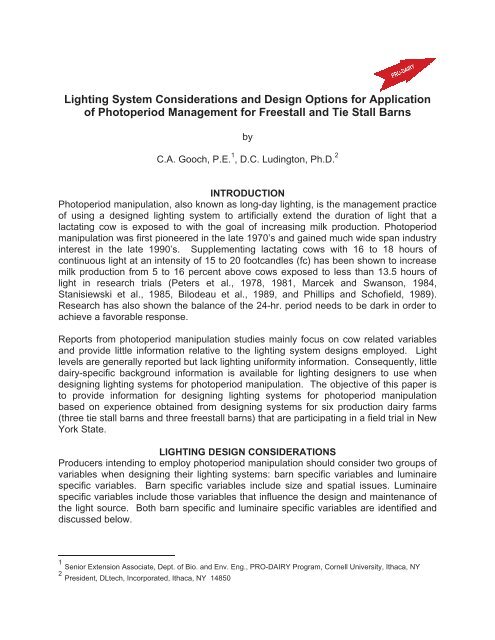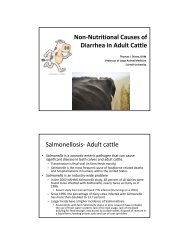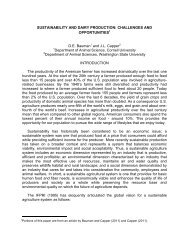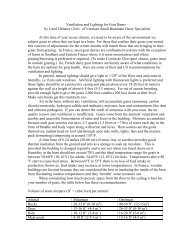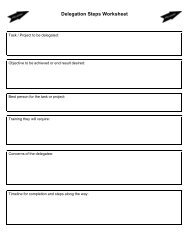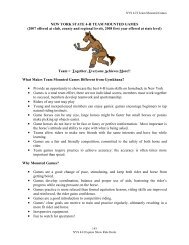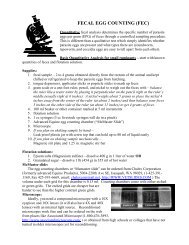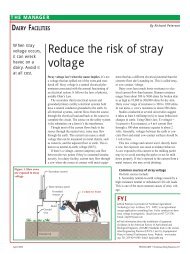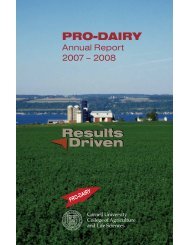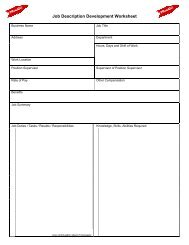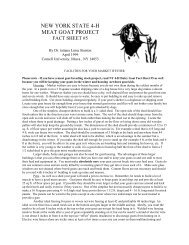Lighting System Considerations and Design Options for Application
Lighting System Considerations and Design Options for Application
Lighting System Considerations and Design Options for Application
- No tags were found...
You also want an ePaper? Increase the reach of your titles
YUMPU automatically turns print PDFs into web optimized ePapers that Google loves.
<strong>Lighting</strong> <strong>System</strong> <strong>Considerations</strong> <strong>and</strong> <strong>Design</strong> <strong>Options</strong> <strong>for</strong> <strong>Application</strong>of Photoperiod Management <strong>for</strong> Freestall <strong>and</strong> Tie Stall BarnsbyC.A. Gooch, P.E. 1 , D.C. Ludington, Ph.D. 2INTRODUCTIONPhotoperiod manipulation, also known as long-day lighting, is the management practiceof using a designed lighting system to artificially extend the duration of light that alactating cow is exposed to with the goal of increasing milk production. Photoperiodmanipulation was first pioneered in the late 1970’s <strong>and</strong> gained much wide span industryinterest in the late 1990’s. Supplementing lactating cows with 16 to 18 hours ofcontinuous light at an intensity of 15 to 20 footc<strong>and</strong>les (fc) has been shown to increasemilk production from 5 to 16 percent above cows exposed to less than 13.5 hours oflight in research trials (Peters et al., 1978, 1981, Marcek <strong>and</strong> Swanson, 1984,Stanisiewski et al., 1985, Bilodeau et al., 1989, <strong>and</strong> Phillips <strong>and</strong> Schofield, 1989).Research has also shown the balance of the 24-hr. period needs to be dark in order toachieve a favorable response.Reports from photoperiod manipulation studies mainly focus on cow related variables<strong>and</strong> provide little in<strong>for</strong>mation relative to the lighting system designs employed. Lightlevels are generally reported but lack lighting uni<strong>for</strong>mity in<strong>for</strong>mation. Consequently, littledairy-specific background in<strong>for</strong>mation is available <strong>for</strong> lighting designers to use whendesigning lighting systems <strong>for</strong> photoperiod manipulation. The objective of this paper isto provide in<strong>for</strong>mation <strong>for</strong> designing lighting systems <strong>for</strong> photoperiod manipulationbased on experience obtained from designing systems <strong>for</strong> six production dairy farms(three tie stall barns <strong>and</strong> three freestall barns) that are participating in a field trial in NewYork State.LIGHTING DESIGN CONSIDERATIONSProducers intending to employ photoperiod manipulation should consider two groups ofvariables when designing their lighting systems: barn specific variables <strong>and</strong> luminairespecific variables. Barn specific variables include size <strong>and</strong> spatial issues. Luminairespecific variables include those variables that influence the design <strong>and</strong> maintenance ofthe light source. Both barn specific <strong>and</strong> luminaire specific variables are identified <strong>and</strong>discussed below.1 Senior Extension Associate, Dept. of Bio. <strong>and</strong> Env. Eng., PRO-DAIRY Program, Cornell University, Ithaca, NY2 President, DLtech, Incorporated, Ithaca, NY 14850
Barn SizeThe length <strong>and</strong> most especially the width of the barn impact lighting design by affectingthe number of fixtures required to provide lighting. Wider barns require more rows ofluminaires to provide target illumination levels than narrower barns. Experience hasshown that most two-, three-, four- <strong>and</strong> six-row barns need at least one, two, three, <strong>and</strong>four rows of lights, respectively to provide adequate lighting <strong>for</strong> photoperiodmanagement. The exact number of rows required also depends on the design of thechosen luminaire <strong>and</strong> its mounting height.Luminaire Mounting HeightThe mounting height is generally defined as the distance from the work plane to thebottom of the luminaire. Mounting heights can vary significantly depending on thestructural design of a barn. Barns that use a conventional truss system usually willhave luminaires mounted to or suspended from the bottom chords of the trusses. Witha given sidewall height, this results in mounting heights that are generally less thanthose obtained in barns that use a rafter system or a glue-laminated arched trusssystem. The preferred mounting height with respect to the building’s structural systemneeds to be kept in mind when evaluating luminaire options. Examples of outfittingvarious barn layouts using different structural systems with luminaires are shown in theAppendix.Work Plane HeightWork plane height is the distance above the floor surface that a lighting intensitymeasurement is taken. For photoperiod management lighting systems, the work planeheight should be two feet. This represents the height of cows’ eyes above the cow alleyfloor (freestall barn) or the litter alley floor (tie stall barn) when resting in the stalls.Targeted light levels of 15 to 20 footc<strong>and</strong>les are desired at cow eye level to create aresponse (Dahl, 2001). Using a work plane height of two feet will result in higher lightlevels reaching the cows’ eyes when they are in a st<strong>and</strong>ing position.Reflectivity of Interior SurfacesReflectivity levels <strong>for</strong> walls, ceiling, <strong>and</strong> floors impact the number of luminaires neededto provide desired light levels. Higher surface reflection coefficients result in increasedlight levels measured at the work plane height. Care should be taken on the part of thelighting designer not to use reflectivity levels found in barns that are new. Dirt quicklybuilds up on wall, ceiling <strong>and</strong> floor surfaces resulting in measurable losses in reflectivity.Reflective values <strong>for</strong> walls is zero <strong>for</strong> freestall barns (worst case scenario is curtainsfully open) <strong>and</strong> up to 10 percent <strong>for</strong> conventional tie stall barns (minimum light reflectedoff walls due to normally dirty conditions). Values <strong>for</strong> ceilings are generally zero sincemost ceilings (if present) are dirty <strong>and</strong>/or the light fixture is designed to direct outputlight in a predominately downward direction. Floors generally have little light reflectancesince they are covered with manure. Ten percent can be used <strong>and</strong> is considered a
conservative design value.<strong>Design</strong> Light Level at Feed Alley <strong>and</strong> Front of StallAppropriate light levels <strong>for</strong> implementing photoperiod manipulation management <strong>for</strong>lactating dairy cows is between 15 <strong>and</strong> 20 footc<strong>and</strong>les (Dahl, 2001). Freestall barnsthat use conventional truss systems that are not clear span <strong>and</strong>/or other barns that useconvective cooling fans to provide summer-time heat stress relief may require specialattention when designing lighting systems due to shadowing. It does not appear to beunderstood at this time if in-the-barn shadowing adversely affects photoperiodresponse.Uni<strong>for</strong>mity of Light Level Along Feed Alley <strong>and</strong> Front of StallUni<strong>for</strong>m light levels, that might imply equal light levels over the floor area of a freestallbarn, do not appear to be necessary. However, light levels in the head area of stalls<strong>and</strong> feed bunks (where the com<strong>for</strong>table cows will spend most of their time), should bedesigned to provide a minimum level of 15 footc<strong>and</strong>les after a defined service periodthat is based on a predicted light loss factor (discussed below). The Appendix hasexamples of both targeted lighting design (lighting areas where cows are doingproductive activities, i.e., eating or resting in stalls) <strong>and</strong> uni<strong>for</strong>m lighting of all cow areas.Type of LuminaireThe type of luminaire that can used to provide lighting includes metal halide (MH), highpressuresodium (HPS), <strong>and</strong> fluorescent. Dahl (2001) indicated that these three lightsources will create a milk yield response. There may be personal preferences withregard to MH <strong>and</strong> HPS luminaires. HPS lights deliver more lumens per Watt than MH,120 vs. 80 <strong>for</strong> example. This is obviously an economic advantage because fewerluminaires are needed to obtain the same average light level (number of lumensmeasured at the work plane) <strong>and</strong> lower connected load (kW). However, achieving“uni<strong>for</strong>m” lighting is easier to provide when using more, lower wattage fixtures.Generally HPS luminaires also have a higher average lamp life. However, MH have ahigher color rendition index (CRI), a measure of the luminaire’s output light color. MHluminaires have a more white output light color while HPS luminaires have ayellowish/orange output color. <strong>Lighting</strong> system designers should consult with the dairyproducer <strong>and</strong> determine their preference <strong>for</strong> luminaire output light color.Fluorescent lights have a lamp life similar to MH. However, fluorescent lamps have alower lamp lumen depreciation factor meaning that they stay brighter longer. In fact,mean light output <strong>for</strong> fluorescent lamps can be 95 percent of the initial light output whileMH may be 65 percent. Mean light output is defined as the light output after 40 percentof average life. Figure 1 shows the comparison of the LLD <strong>for</strong> three lamps. The ratedaverage life <strong>for</strong> fluorescent <strong>and</strong> MH lights is determined when 50 percent of theinstalled lights are still operating.
Type of Ballast/lampPulse start MH lamps <strong>and</strong> fixtures have higher initial light output <strong>and</strong> a lower lamplumen depreciation factor when compared to st<strong>and</strong>ard probe start MH luminaires. For320 <strong>and</strong> 450 W pulse start MH, rated life is determined when 70 percent of the lightsinstalled are still operating.LAMP LUMEN DEPRECIATION110Relative Light Output,percent1009080706050Fluorescent, T8High Pressure SodiumStd Metal Halide0 5 10 15 20 25Hours of Operation, thous<strong>and</strong>sFigure 1. Lamp lumen depreciations <strong>for</strong> T-8 fluorescent, high pressure sodium, <strong>and</strong> st<strong>and</strong>ardprobe start design metal halide luninaires.<strong>Design</strong> of Light DiffuserThe distribution of light (lumens) from a fixture varies with the design of the diffuser(lens). This can have a significant affect on the number <strong>and</strong> location of the luminaires.Manufacturer’s photometric data should be consulted <strong>and</strong> used when evaluating aspecific luminaire with respect to the intended mounting height. A comparison of fourcombinations of housings <strong>and</strong> lenses <strong>for</strong> a 250 Watt MH luminaire is shown in Figure 2.Light Loss FactorLight loss factor (LLF) is a function of lamp lumen depreciation (LLD), luminaire dirtdepreciation (LDD) <strong>and</strong> room surface dirt depreciation (RSDD); LLF = LLD x LDD xRSDD. Lamp lumen depreciation is a measure of the decrease in lumen output of aluminaire due to use. Manufacturers of lighting elements have data tables <strong>for</strong> the LLDof their products. LLD is influenced by the operating cycles. For MH, operating cycle of11 hrs on <strong>and</strong> 1 hr off is suggested by IESNA <strong>and</strong> 3 hr cycle <strong>for</strong> fluorescent lamps. Dirtdepreciation is a measure of the decrease in lumen output of a luminaire due to dirtbuild up on the luminaire’s diffuser. Dirt buildup is based on the environment theluminaire is exposed to. Significant dirt build up occurs from dirt particles settling on the
25Intensity, footc<strong>and</strong>les201510500 5 10 15 20 25 30 35 40 45 50 55 60Location, feetTXP P26 TXP A26 TXL A20 TXC A23Figure 2. Comparison of different combinations of housings <strong>and</strong> lenses <strong>for</strong> a 250 Watt low baypulse start luminaire. Luminaire spacing <strong>and</strong> mounting height of 25 <strong>and</strong> 17 feet, respectively.light diffuser as well as particles attracted by electrostatic <strong>for</strong>ces. Fly dirt also isdeposited on diffusers in dairy barns. While significant design data exists <strong>for</strong> dirtdepreciation of luminaires used in residential, commercial, <strong>and</strong> industrial settings, nosimilar data exists <strong>for</strong> dairy facilities. At this time designers must use data from theseapplications to approximate the environment found in dairy barns. The authors aredeveloping dirt depreciation data from the field studies currently being conducted.The effect of LLD on lumen output <strong>for</strong> 5 different luminaries is shown in Figure 3; 400W st<strong>and</strong>ard MH, 320 W pulse start MH, 350 W pulse start MH <strong>and</strong> 360 W pulse startStay Bright pulse start <strong>and</strong> a 360 W Watt-Miser. All the pulse start luminaries havelower LLD than the st<strong>and</strong>ard MH. Using 16 hours per day <strong>for</strong> photo manipulation isequal to 5,800 hours per year. For the st<strong>and</strong>ard MH the lumen output has beenreduced nearly one-third while the lumen output from the 350 W PS lamp hasdecreased only 21 percent.Both LLD <strong>and</strong> DDF are a function of time. Consequently, designers must designlighting systems that provide the target level of light at some point of time after lights arefirst turned on. For photoperiod controlled lighting systems, experience has shown thatinitial light levels may be designed <strong>for</strong> 20 to 25 footc<strong>and</strong>les in order to have ensure aminimum of 15 footc<strong>and</strong>les after 2 years of service life. <strong>Lighting</strong> systems <strong>for</strong> freestallbarns largely consist of using metal halide or high pressure Sodium high intensitydischarge (HID) fixtures. Due to the LLD factor <strong>for</strong> these fixtures, the suggested
elamping schedule is 2 years. Using data from industrial applications to approximatethe DDF in a dairy environment, it is recommended at this point that the fixtures becleaned every six months.40,000Light Output, Lumens36,00032,00028,00024,00020,0000 1,000 2,000 3,000 4,000 5,000 6,000 7,000 8,000Hours of Operation400W Std-L 320W PS-L 350W PS-L360W Stay Bright PS360 W Watt-MiserFigure 3. Lamp lumen depreciation <strong>for</strong> metal halide lights with various wattages <strong>and</strong> lamp strikemethods.A prudent photoperiod lighting system design will specify luminaire relamping <strong>and</strong>cleaning schedules. <strong>System</strong>s designed with more frequent maintenance schedules willrequire fewer fixtures <strong>and</strong> there<strong>for</strong>e less initial capital cost to install them <strong>and</strong> less cost<strong>for</strong> operation. However, the increased maintenance frequency will result in increasedannual maintenance costs.Impact of Air TemperatureThe temperature of the air adjacent to a luminaire can affect its lumen output, as shownin Figure 4. Field research has shown that the light output from fluorescent fixtures isreduced by approximately 50 percent as temperatures dropped to 10°F or below infreestall barns. This is a minor problem since most commercial freestall barns would beilluminated with HID light fixtures which do not negatively respond to temperatures likefluorescent fixtures do, coupled with the fact that tie stall barns that use fluorescentlighting are temperature moderated in extreme winter conditions. However, olderfreestall barns that have low (< 10 foot) sidewalls many require fluorescent fixtures toilluminate the outside rows of stalls.
Percent of RatedLumens120100806040200-10 10 30 50 70 90Figure 4. Effect of ambient air temperature on light output <strong>for</strong> a T-12 high output luminaire.Electrical Dem<strong>and</strong>sStill Air Temperature, FLuminairesThe electrical dem<strong>and</strong> needs to be calculated <strong>for</strong> each different luminaire that is used.The total dem<strong>and</strong> <strong>for</strong> each luminaire consists of the dem<strong>and</strong> created by the lamp/bulb<strong>and</strong> the ballast. Many times the ballast dem<strong>and</strong> is omitted because manufacturersmarket luminaires based on the wattage of the lamp/bulb only. The input power <strong>for</strong> theHID luminaire is approximately 115 percent of the lamp wattage. Using an averagevalue of 115 percent, the total dem<strong>and</strong> <strong>for</strong> the manufacturer’s 250 Watt fixture is 285Watts.Control ClocksThe controls <strong>for</strong> the luminaries used <strong>for</strong> photoperiod manipulation all have ballastswhich means there will be inrush current when the ballasts are energized. The currentrating <strong>for</strong> ballast loads is considerably lower than <strong>for</strong> resistive loads. Onetimer/controller has a rating of 30 amps resistive <strong>and</strong> 6 amps ballast. Solid state relays,that will h<strong>and</strong>le 10 times the inrush current, <strong>and</strong> magnetic contactors are suitable.Light Level <strong>for</strong> Dark PeriodThe definition of “dark” during the 6 to 8 hr. lights off period is not well understood byresearchers. In other words, there does not appear to be a quantitative value thatestablishes the threshold <strong>for</strong> dark. Dahl (2001) indicated that all photoperiod lightsshould be turned off during the continuous dark period. The use of security lights orother night lights is generally not recommended as light levels above 5 footc<strong>and</strong>les arebelieved to potentially adversely affect milk production response. Difficulty arises inproviding completely dark periods in large barns on farms that milk three times daily<strong>and</strong> operate around the clock, <strong>and</strong> on farms where much emphasis is placed on stallcleanliness <strong>and</strong> observing cows <strong>for</strong> general well-being <strong>and</strong> signs of estrous. Dahl(2001) recommended the use of low wattage red lights located in barns as a means toprovide lighting <strong>for</strong> human needs during the dark period. Field experience showed thattwo rows of low wattage red lights mounted directly above stall rows <strong>and</strong> spaced 24 feet
apart with a mounting height of 18 to 20 feet above the floor surface do not providesufficient light in large freestall barns to meet human needs. Minimal lighting wasobtained on one of the participating study farms by replacing the red lights with whiteinc<strong>and</strong>escent bulbs <strong>and</strong> installing a dimmer on each lighting circuit. By adjusting thedimmer switch, the measured light level at the work plane was lowered to 0.2footc<strong>and</strong>les <strong>and</strong> deemed acceptable by the farm owner when considering his othergoals. At 0.2 footc<strong>and</strong>les cows can easily be seen <strong>and</strong> identified by ear tags <strong>and</strong> stallbeds can be cleaned <strong>and</strong> maintained. It is undecided whether providing this low-levellighting adversely affects photoperiod milk response.<strong>Lighting</strong> <strong>for</strong> Milking Center<strong>Lighting</strong> design <strong>for</strong> a milking center is generally focused on providing target light levelsat cows’ udders. With the implementation of photoperiod manipulation on the farm,more consideration must be given to lighting design to ensure that cows receive 15 to20 footc<strong>and</strong>les of light in the holding area <strong>and</strong> cow decks if they are in these areasduring their scheduled “lights on” period <strong>and</strong> no light if during the dark period. The“lights on” period is easy to accommodate by designing a lighting system that willprovide lighting throughout these areas. The “lights off” period is more difficult due tothe continued need to provide lighting <strong>for</strong> milking purposes. Although not researched bythe authors to date, a suitable system that meets the needs <strong>for</strong> no light at the cow’s eyeyet provides sufficient light at the udder should be able to be designed.SUMMARYThe design of lighting systems <strong>for</strong> photoperiod manipulation needs to consider twospecific groups of lighting design variables: barn specific variables <strong>and</strong> luminairespecific variables. Barn specific variables include size <strong>and</strong> spatial issues. Luminairespecific variables include those variables specific to luminaire design <strong>and</strong> in-servicemaintenance. Additional research is needed to determine the minimal level ofallowable light during the dark period <strong>and</strong> the uni<strong>for</strong>mity of light needed during the litperiod to achieve a response. Minimal lighting is required in many barns due to thepresence of near continuous activity that involves humans. This additional in<strong>for</strong>mationwill be helpful to lighting designers.REFERENCESBilodeau, P.P., D. Petiticlerc, N. St. Pierre, G. Pelletier, <strong>and</strong> G. J. Laurent. 1989.Effects of photoperiod <strong>and</strong> pair-feeding on lactation of cows fed corn or barley grain intotal mixed rations. J. Dairy Sci. 72:2999.Dahl, G. E. 2001. Personal Communication. Associate Professor of Animal Sciences.University of Illinois at Urbana-Champaign.
IESNA. Illuminating Engineering Society of North America. <strong>Lighting</strong> H<strong>and</strong>book. 9 thEdition. 2000Marcek, J. M. <strong>and</strong> L. V. Swanson. 1984. Effect of photoperiod on milk production <strong>and</strong>prolactin of Holstein dairy cows. J. Dairy Sci. 67:2380.Peters, R. R., L. T. Chapin, R. S. Emery, <strong>and</strong> H.A. Tucker. 1981. Milk yield, feedintake, prolactin, growth hormone, <strong>and</strong> glucocorticoid response of cows to supplementallight. J. Dairy Sci. 64:1671.Peters, R. R., L. T. Chapin, K. B. Leining, <strong>and</strong> H. A. Tucker. 1978. Supplementallighting stimulates growth <strong>and</strong> lactation in cattle. Science 199:911.Phillips, C. J. C., <strong>and</strong> S. A. Scholfield. 1989. The effects of supplemental light on theproduction <strong>and</strong> behavior of dairy cows. Amim. Prod. 48:293.Stanisiewski, E. P., R. W. Mellenberger, C. R. Anderson, <strong>and</strong> H. A. Tucker. 1985.Effect of photoperiod on milk yield <strong>and</strong> milk fat in commercial dairy herds. J. DairyScience 68:1134.
APPENDIXUni<strong>for</strong>m lighting system <strong>for</strong> a 3-row freestall barn with conventional truss design.Targeted lighting system <strong>for</strong> a 4-row head to head freestall barn with conventional truss design.
Targeted lighting system <strong>for</strong> a 4-row head to head freestall barn with rafter design.Targeted lighting system <strong>for</strong> a 6-row freestall barn with conventional truss design.
Targeted lighting system <strong>for</strong> a 6-row freestall barn with rafter design.Targeted lighting system <strong>for</strong> a 2-row freestall barn with conventional truss construction.


